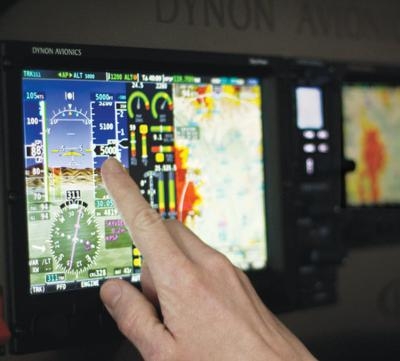New Dynon SkyView Touch Responds To Touchscreen Interface As Well As Mechanical Controls
One of the more common questions asked about touchscreen avionics is "what about turbulence?" Dynon Avionics thinks it has answered that question for its target segment of the market with its SkyView Touch system.

The company says From the beginning, its pilots designed SkyView to have a clean and intuitive pilot interface through its on-screen buttons and joystick knobs. With new dedicated control panels and SkyView Touch™ as options, there’s a pilot interface for every flying style. So whether you’re new to glass cockpit technology or fly 777s at work, there’s a SkyView panel for you.
SkyView’s new “six-pack” flight instrumentation mode (pictured) lets you fly the gauges you’re used to with the digital “EFIS glass cockpit” presentation just a few buttons away. Try out the “EFIS” style as you get comfortable. Or not. It’s up to you. Learn about SkyView features with training videos on The Dynon Channel and educational posts on the Preflight Brief. Add an in-person training class at fly-ins or at our Seattle HQ and you’re cleared for takeoff.
If you like dedicated controls, you are covered. The knob control panel assigns the items you adjust most to dedicated knobs, freeing up the multi-use SkyView joysticks and lowering pilot workload. Similarly, the Autopilot control panel removes the need to ever use the on-screen menus for Autopilot mode changes. If you have the panel space, these modules are simply the right way to interact with your avionics.
Dynon says that SkyView Touch was designed to complement SkyView’s existing interface, not replace it. This allows you to rely on SkyView's complete set of buttons and joystick knobs when you need them most. This is critical for effective control in turbulence: While you usually hold a smartphone or tablet in your hands, your EFIS screen is at the end of your outstretched arm, and it’s moving with the aircraft, not with you. These two things conspire to make touch control less than ideal when things get bumpy.

Starting with those challenges, Dynon says they designed a touch interface specifically for the cockpit. Touch actions are designed to be easy to learn and are used in places where they can reduce pilot workload the most. For example, touching the transponder or autopilot status displays instantly enables those features’ controls, eliminating the normal button pushes you’d use to access those menus.
Similarly, touching a PFD item that has an adjustable bug instantly reassigns a SkyView joystick knob to the touched bug, eliminating the need to manually re-task that knob. Using your fingertips to pan, zoom, and select items on the map works just as you’d expect it to. And, since SkyView Touch has the exact bezel footprint as existing displays, every SkyView D1000 customer has an affordable upgrade path that doesn’t require cutting a new panel or even a single wire change.
 ANN's Daily Aero-Linx (05.02.24)
ANN's Daily Aero-Linx (05.02.24) ANN's Daily Aero-Term (05.02.24): Touchdown Zone Lighting
ANN's Daily Aero-Term (05.02.24): Touchdown Zone Lighting Aero-News: Quote of the Day (05.02.24)
Aero-News: Quote of the Day (05.02.24) ANN FAQ: Contributing To Aero-TV
ANN FAQ: Contributing To Aero-TV NTSB Final Report: Cirrus Design Corp SR20
NTSB Final Report: Cirrus Design Corp SR20




